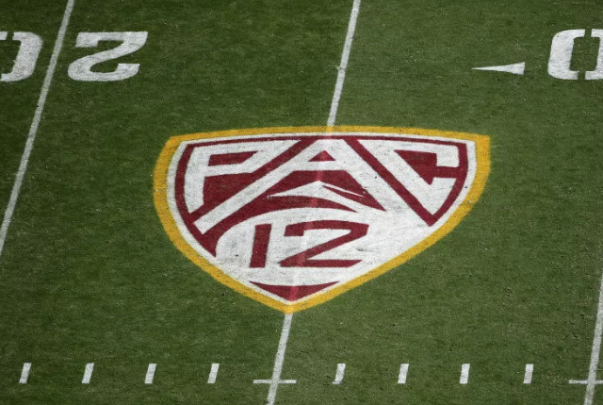Triple-Headed Monster Ready to Devour the Pac-12 and College Sports

Pac-12 schools and fans lament their lack of a new television contract. That’s only part of the problem; the rest is out of their control.
It’s no secret that college athletics as we know them are about to go up in smoke. Well, I’m pulling the alarm because this house is on fire.
TV Rights
The Pac-12‘s seemingly ongoing saga of trying to secure a media rights deal is just one part of the overall picture. While Commissioner George Kliavkoff says it’s a bonus to be the only Power 5 conference with availability, it feels like the music stopped, and the four chairs are filled, leaving the Conference of Champions out of the game.
What the conference is finding out the hard way is that there isn’t an unlimited pool of money that networks and streamers have to pay for college sports. What was previously a battle to control media markets is now a race to get eyeballs on broadcasts. And the Pac-12 has been losing that one for years.
While the Pac-12 is facing immediate issues, they aren’t alone. There is so much more to the current television rights situation. The 7-year, $7B television the Big Ten negotiated last year is not finished and has some holes in it that need to be addressed before it kicks in this fall.
Among them is the primetime package with NBC. It’s no secret that the Big Ten Schools don’t like playing night games after the first week of November. It gets really cold in that part of the country. Schools such as Michigan, Michigan State, and Penn State have already balked at playing late-season night games.
If that aspect isn’t resolved, it devalues the rights deal.
Speaking of NBC, because former Commissioner Kevin Warren promised the 2026 Big Ten Championship game to the network without permission, the conference has to reimburse FOX $40M. They also owe FOX another $25M for lost games in 2020 due to the pandemic.
To make it a majority of Power 5 conferences with issues, a rebellion was recently quelled within the Atlantic Coast Conference. At least seven schools looked into voiding the grant of rights deal they signed through 2036 because they can’t compete with the financial resources SEC and Big Ten members are getting in their new media packages.
Because of that, the ACC had to change its revenue distribution model this week. Otherwise, schools like Florida State and Clemson would look for greener pastures.
The Power 5 is about to become the Power 4. It’s very possible in the next cycle of rights negotiations, we’ll see major conference realignment. How that shakes out is another question altogether.
Consider this; there are four major television networks ABC, NBC, CBS, and FOX. ESPN is going to be an all-streaming network in a few years; they’ll join the other major players, AppleTV, Amazon, and YouTubeTV (Google).
California Bill AB252
As a result of their 2021 Supreme Court loss, the NCAA allows athletes to get their scholarship, a $4,000 cost-of-attendance stipend, and $5,980 in education-related benefits.
Buoyed by their leadership in NIL, the California State Legislature is at it again. Assembly Bill 52 would require state schools to pay football and basketball players based on a revenue sharing model. The amount would be based on the revenues reported to the Department of Education and is supported by the National College Players Association.
As reported by Sportico:
Based on EADA data, in the pre-pandemic academic year of 2019, the legislation would have paved the way for UCLA to pay each of its men’s basketball players $389,000, football players $185,000, women’s gymnasts $5,500 and volleyball players $871, assuming the school availed itself of the NCAA’s maximum scholarship limits for those sports. No other sport, including women’s basketball, would have triggered payments under the formula.
Aside from the huge Title IX violations, there are so many holes that are unfair to other groups that it’s ridiculous.
First, it creates a huge disparity between California schools. Based on revenue shares, why would any recruit sign with Fresno State or UC Santa Barbra if they have an offer from USC?
Not only the California schools but every other institution that fields teams. Most athletic programs run a deficit. There is no way Washington State could compete with Stanford or Cal (that is, if Cal ever turns a profit).
It creates too much of a competitive imbalance, especially within the Pac-12’s footprint. Supporters believe a revenue share is a way to avoid athletes becoming school employees. The bill is opposed by both the University of California system and the California State University system, which should speak volumes.
That brings us to…
NLRB v.s NCAA, Pac-12, and USC
Two weeks ago, the National Labor Relations Board filed a complaint against the NCAA, Pac-12, and the University of Southern California. According to USA Today, in this complaint, the NLRB seeks:
“An order requiring those three entities to “reclassify the Players as employees rather than as ‘student-athletes’ in their files, including, but not limited to, their handbooks and rules, and notify all current Players that they have done so,” according to the complaint, which was issued under the National Labor Relations Act.”
They will also ask the Administrative Law Judge “for all other relief as may be just and proper to remedy the unfair labor practices alleged.”
This action reeks of politics. While the NCAA is currently a popular target for lawsuits, the Pac-12 and USC are new.
Especially USC. It’s interesting that NLRB general counsel Jennifer Abruzzo chose USC. They are a private university.
Because if athletes at a public school were deemed employees, they would be state employees, the same as coaches, professors, DMV clerks, the governor, and the state courthouse janitor.
The case is scheduled for November 7, 2023.
Even if everything goes the positively in these three areas for the Pac-12 and NCAA, troubles are far from over. It would be more of a stay of execution than a permanent resolution.
